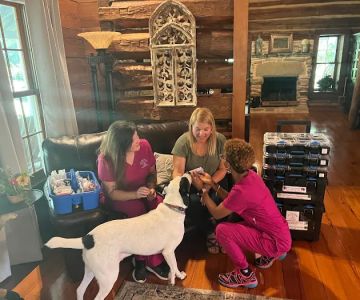Understanding the Working Conditions for a Veterinarian – Insights into Daily Life
- 1. Overview of Working Conditions for Veterinarians
- 2. Daily Life of a Veterinarian
- 3. The Veterinary Workplace Environment
- 4. Challenges Veterinarians Face in Their Careers
- 5. How to Prepare for a Career in Veterinary Medicine
1. Overview of Working Conditions for Veterinarians
Veterinary professionals face a unique set of working conditions that differ from those of many other medical professionals. While veterinarians provide essential care for animals, they often work long hours, deal with challenging emotional situations, and manage physical demands. Their working environment can vary significantly depending on their specialization—whether they work in a private practice, a zoo, a research lab, or a public health setting.
The working conditions for a veterinarian are shaped by various factors, including their field of expertise, the size and type of practice they work in, and the specific duties of their role. Whether treating pets, farm animals, or wildlife, each setting presents its own set of challenges and rewards. In this article, we'll dive into the daily life of a veterinarian, explore their workplace environment, and look at the challenges they face in their profession.
2. Daily Life of a Veterinarian
The daily life of a veterinarian can be as varied as the animals they treat. Veterinarians may start their day with a series of routine checkups, such as vaccinations, health screenings, and preventive care for pets. However, their day can quickly turn to more complex procedures, including surgeries or emergency care for injured animals.
Routine Care
In private practices, veterinarians often have a set schedule, seeing patients in 20-30 minute intervals. This routine can include administering vaccines, conducting physical exams, and offering consultations to pet owners on nutrition, behavior, and overall wellness. However, even routine visits may present surprises, as animals can often behave unpredictably during visits, requiring quick thinking and adaptability.
Emergency Care and Surgeries
For veterinarians working in emergency clinics, their day might involve handling critical care patients—animals that require immediate attention for life-threatening injuries or conditions. In these settings, veterinarians must be prepared for high-pressure situations, including surgeries and complex medical procedures, all while managing the emotional and physical demands of the job.
Specializations and Other Areas of Work
Specialists in fields like oncology, cardiology, or dermatology may have more predictable work hours but still face significant challenges in diagnosing and treating specific conditions. Some veterinarians also work in research or academic settings, contributing to advancements in veterinary medicine through studies, clinical trials, or teaching the next generation of veterinary professionals.
3. The Veterinary Workplace Environment
The workplace environment for a veterinarian can vary greatly depending on the setting. Those in private practice often work in small clinics, sometimes alongside a team of technicians, nurses, and office staff. In contrast, veterinarians working at animal hospitals or research institutions might have access to cutting-edge medical equipment and work in more collaborative, interdisciplinary teams.
Private Practice
In private practice, veterinarians typically see clients on an appointment basis, though they may be required to handle emergency cases as they arise. The environment is usually quieter and more personal, allowing for longer consultations with pet owners. This can create an atmosphere of trust and care, as veterinarians often form long-term relationships with their patients and clients.
Animal Hospitals and Emergency Clinics
Animal hospitals and emergency clinics tend to be more fast-paced environments. These settings are often bustling with activity, as veterinarians handle a larger volume of patients with diverse conditions. The pressure to act quickly and accurately is higher in these environments, especially when it comes to life-threatening emergencies.
Research and Education Settings
Veterinarians working in research or teaching often spend their time in laboratories, classrooms, or teaching hospitals. They may not deal directly with patients but focus instead on advancing medical knowledge or mentoring students. The environment is more structured, with less emotional pressure but a different set of challenges, such as securing research funding or publishing results.
4. Challenges Veterinarians Face in Their Careers
While working as a veterinarian can be immensely rewarding, it is not without its challenges. Some of the most significant difficulties faced by veterinarians include long working hours, emotional stress, and physical exhaustion. In private practices, the demand for emergency care can lead to unexpected late-night hours, and the need to respond to urgent calls adds to the strain. Additionally, veterinarians working in animal shelters may have to face emotionally taxing situations, such as euthanizing animals or treating severe neglect cases.
Another challenge is the financial strain. Veterinary education is expensive, and many professionals enter the workforce with significant student loan debt. The average salary for veterinarians, although competitive, may not always match the level of responsibility or stress involved in their roles. The financial aspect can be a significant factor in career satisfaction.
5. How to Prepare for a Career in Veterinary Medicine
Preparing for a career as a veterinarian requires a significant commitment of time, energy, and resources. It typically starts with completing a bachelor's degree in a related field, such as animal science or biology. Veterinary school then adds another 4 years of study, followed by internships and residencies in specialized fields. Practical experience, including internships at veterinary clinics, animal shelters, or research labs, is invaluable in building the skills needed for success in the field.
In addition to formal education and training, aspiring veterinarians should develop strong communication and emotional resilience skills. This is crucial for working effectively with clients and handling difficult situations with compassion. Understanding the working conditions of a veterinarian before entering the field can help individuals make informed decisions and better prepare for the challenges ahead.











